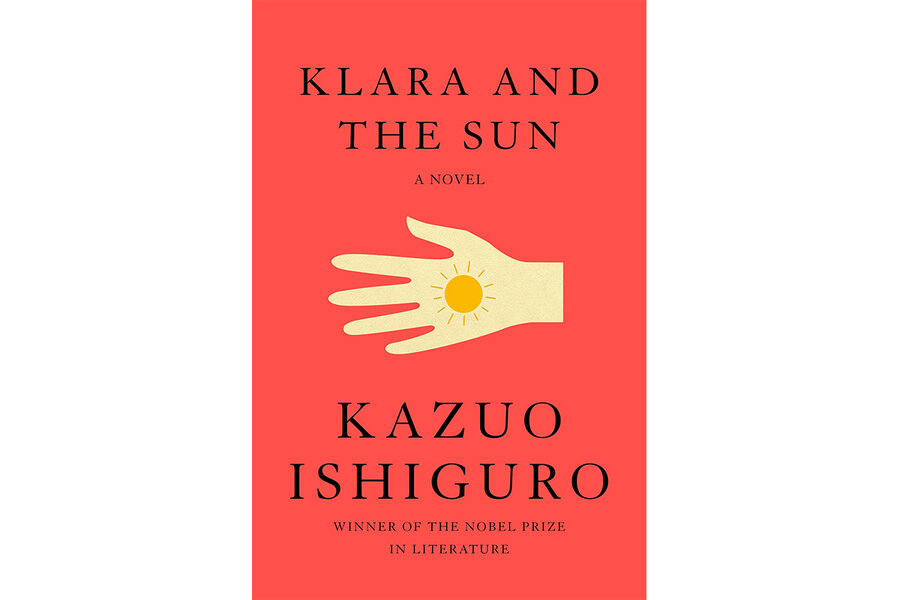‘Klara and the Sun’: Do androids dream of human emotions?
What makes a person “special and individual” and therefore irreplaceable? Is there something unreachable and nontransferable deep inside each of us, something uniquely human that even advanced science and artificial intelligence can’t fathom or duplicate? These are questions that Kazuo Ishiguro probes in “Klara and the Sun,” his first new novel since winning the Nobel Prize in 2017.
Like “Never Let Me Go,” Ishiguro’s discomfiting 2005 dystopian novel about clones raised to be organ donors, his latest involves science taken to sinister, ethically questionable levels. But it is also a surprisingly warm morality tale about love, heart, hope, empathy, and the idea that “there are all kinds of ways to lead a successful life.”
The book is narrated by Klara, an uncommonly observant and sympathetic solar-powered AF (artificial friend) whose mandate is to closely study her teenage charge, a girl named Josie, to better fulfill her role as Josie’s caring companion.
Like the butler in Ishiguro’s Booker Prize-winning “The Remains of the Day,” Klara has a limited purview – partly because of her subservient, low social standing in Josie’s household, but also because she isn’t human. Her manner is simple, her speech direct, and her personality is without wiles, but she’s no dummy.
Klara worships the sun, which fuels her, and she is convinced that harnessing his power (she views the sun as masculine) will make Josie, who is in poor health, well again. This idea is taken to sometimes cloying extremes, but while Klara is by design intensely focused on her charge’s well-being, this is not another Ishiguro novel whose characters are so wrapped up in the minutiae of their daily lives that they ignore the big, darker picture.
In fact, Ishiguro upends our expectations: Klara, although a technological breakthrough, is – unlike the artificial human in Ian McEwan’s 2019 novel, “Machines Like Me” – not creepy. Without giving away too much, I can say that the novel’s principal – and far creepier – ethical issue involves genetic manipulations that confer special social and educational advantages, which leads to an unfair, stratified society. These “edits” can also carry grave health risks.
Klara’s perspective – her literal point of view – is key to the novel, which opens in the city shop where she awaits purchase, along with more sophisticated, newer model AFs. When she is moved from mid-store to the front window, she revels in the extra exposure to sunlight and the expanded view: “I’d always longed to see more of the outside – and to see it in all its detail,” she says.
Ishiguro carefully limits our perspective to what Klara takes in, which means physical details in particular are often scant: Josie is thin, with an “uncertain stride”; her mother is tense and wears “high-rank office clothes.” We never learn exactly what the mother does when she drives off to work every day (lawyer, perhaps), and why she wasn’t “substituted” by AI like Josie’s absent father, a brilliant engineer, who now lives in a rough community of outliers.
Also, unlike McEwan’s fully functioning artificial man, we never learn much about Klara’s physical being. Does she have skin? How human does she look? Josie’s description of her, later quoted by Klara, is likewise limited – to a teenager’s perspective: “really cute, and really smart. Looked almost French? Short hair, quite dark, and all her clothes were like dark too and she had the kindest eyes and she was so smart.”
We do learn, however, that Klara can’t smell, which she tells Josie’s boyfriend, Rick, when he apologizes for the odor of the ramshackle house in which he lives with his disheveled mother. This household provides a troubling window into the limited prospects for the “unlifted” in this brave new world. For one thing, they do not have expensive androids, and Rick’s mother, on meeting Klara, wonders whether she’s supposed to treat her like a guest, or “like a vacuum cleaner.” Klara does not take offense, but readers feel the question’s sting.
“Klara and the Sun” touches on a number of weighty issues, including the insidious encroachments of AI technology; the repercussions of rampant inequality; the degradation of the environment (with smog that, to Klara’s dismay, blocks the sun’s benefits); and the prevalence of loneliness. In her dogged attempts to understand humans, Klara tries to untangle what makes them act the way they do; is it something to do with what Josie’s father calls “the human heart ... in the poetic sense”?
Ishiguro’s intrinsically honest narrator is limited, but she has depth. This is a character whose vision goes wonky and fractures into tiny boxes when she is overwhelmed by what she sees, yet who never stops trying to synthesize the pieces.
The book’s cinematic final scene, which underscores Ishiguro’s theme of obsolescence in the face of rapidly advancing technology, may strike readers as desolate. But Ishiguro chooses to play up its more hopeful aspects by having ever-sunny Klara use this time as an opportunity to process all she’s experienced. And his unusually likable android comes to a radiant epiphany about Josie – and by extension, other humans: “There was something very special, but it wasn’t inside Josie. It was inside those who loved her.” Corny? Well, yes. But also wise and sweet – and a pleasant subversion of what we expect from a dystopian story about the dangers of technology taken too far.
In addition to the Monitor, Heller McAlpin reviews books regularly for NPR and The Wall Street Journal, among other publications.






